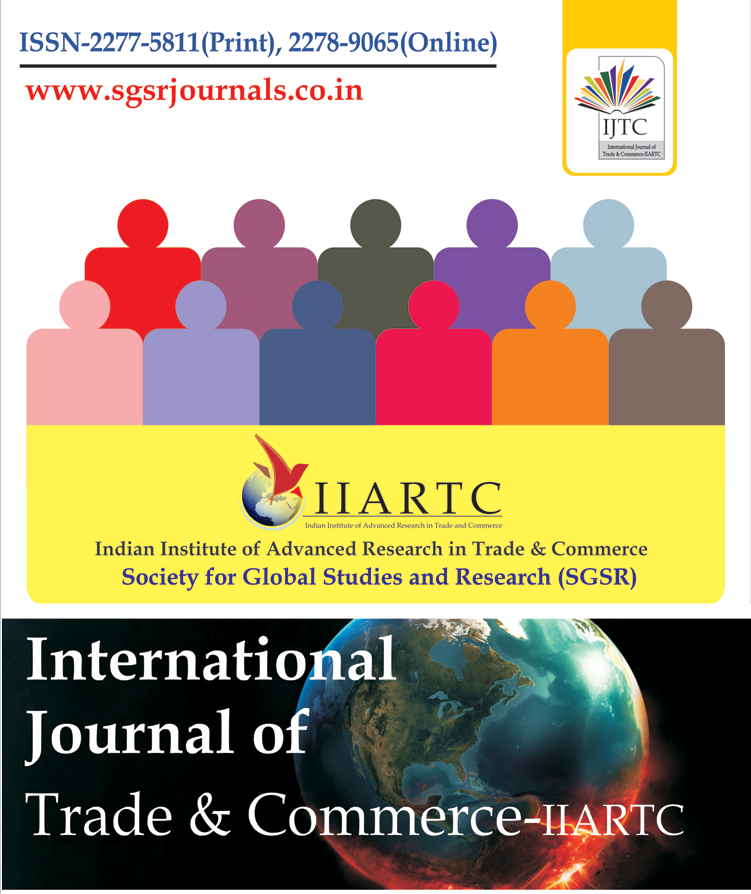Home ⇨ International Journal of Trade & Commerce-IIARTC

International Journal of Trade & Commerce-IIARTC
Impact Factor (IF):5.135 (COSMOS), IF:7.249 (ISRA), IF:3.721 (ISI)
ISSN:2277-5811 (P), ISSN:2278-9065 (O)
Frequency: Half Yearly
Critical Analysis of Water Pollution and its Impact on Society
Water pollution is a serious environmental issue in India as 70 percent of the surface and groundwater resources are contaminated by various pollutants such as biological, toxic, organic, and inorganic. Among all the largest sources of water pollution in India is untreated sewage. Agricultural runoff and unregulated small-scale industry are the other sources of pollution. Most of the rivers, lakes, and surface water in our country are polluted due to industries, untreated sewage, and solid wastes. The outcome of this mammoth problem is the rising socio-economic cost of poor water quality. Approximately 40 million liters of wastewater enter rivers and other water bodies every day, with a tiny fraction of the made quietly treated. Due to water pollution, the most badly hit class is the weaker sections of the society as these people primarily reside near central water bodies in India. As per the World Bank report, such releases of pollution in the up streams reduce the downstream areas' economic growth. It reduces the growth of GDP in these regions, which creates a low impact on the overall GDP of the country. Almost half of the GDP is lost. Due to the polluted stretches in India, the agricultural revenues decrease to 9%, and a 16% fall in agricultural yields downstream areas. Some remedial measures should be adopted to protect the poor masses of the country. Water pollution near oceans, rivers, lakes should be controlled. Waste ingredients should not be disposed of in oceans, rivers, lakes, and groundwater. Controlled use of pesticides and fertilizers should be done to prevent runoffs of the material into nearby water sources. Clean water bodies will result in the sustained development of the country, particularly the vulnerable sections of society. The hour requires to control 'water pollution to achieve the vision of the' healthy nation.
Author:Neelam Kumari *
Abstract:Water pollution is a serious environmental issue in India as 70 percent of the surface and groundwater resources are contaminated by various pollutants such as biological, toxic, organic, and inorganic. Among all the largest sources of water pollution in India is untreated sewage. Agricultural runoff and unregulated small-scale industry are the other sources of pollution. Most of the rivers, lakes, and surface water in our country are polluted due to industries, untreated sewage, and solid wastes. The outcome of this mammoth problem is the rising socio-economic cost of poor water quality. Approximately 40 million liters of wastewater enter rivers and other water bodies every day, with a tiny fraction of the made quietly treated. Due to water pollution, the most badly hit class is the weaker sections of the society as these people primarily reside near central water bodies in India. As per the World Bank report, such releases of pollution in the up streams reduce the downstream areas' economic growth. It reduces the growth of GDP in these regions, which creates a low impact on the overall GDP of the country. Almost half of the GDP is lost. Due to the polluted stretches in India, the agricultural revenues decrease to 9%, and a 16% fall in agricultural yields downstream areas. Some remedial measures should be adopted to protect the poor masses of the country. Water pollution near oceans, rivers, lakes should be controlled. Waste ingredients should not be disposed of in oceans, rivers, lakes, and groundwater. Controlled use of pesticides and fertilizers should be done to prevent runoffs of the material into nearby water sources. Clean water bodies will result in the sustained development of the country, particularly the vulnerable sections of society. The hour requires to control 'water pollution to achieve the vision of the' healthy nation.




